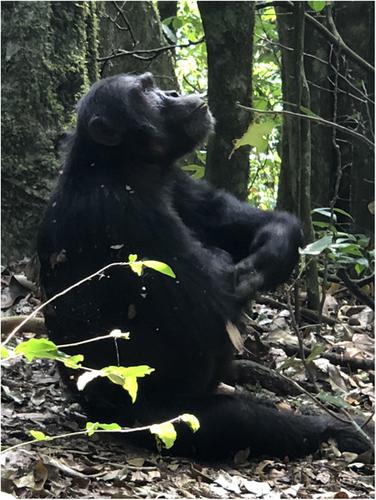当前位置:
X-MOL 学术
›
Am. J. Primatol.
›
论文详情
Our official English website, www.x-mol.net, welcomes your
feedback! (Note: you will need to create a separate account there.)
Opportunities for respiratory disease transmission from people to chimpanzees at an East African tourism site
American Journal of Primatology ( IF 2.0 ) Pub Date : 2021-01-05 , DOI: 10.1002/ajp.23228 Darcey B Glasser 1 , Tony L Goldberg 2 , Nelson Guma 3 , Godfrey Balyesiima 3 , Hillary Agaba 3 , Simplicious J Gessa 3 , Jessica M Rothman 3, 4, 5
American Journal of Primatology ( IF 2.0 ) Pub Date : 2021-01-05 , DOI: 10.1002/ajp.23228 Darcey B Glasser 1 , Tony L Goldberg 2 , Nelson Guma 3 , Godfrey Balyesiima 3 , Hillary Agaba 3 , Simplicious J Gessa 3 , Jessica M Rothman 3, 4, 5
Affiliation

|
Respiratory illnesses, including COVID‐19, present a serious threat to endangered wild chimpanzee (Pan troglodytes) populations. In some parts of sub‐Saharan Africa, chimpanzee tracking is a popular tourism activity, offering visitors a chance to view apes in their natural habitats. Chimpanzee tourism is an important source of revenue and thus benefits conservation; however, chimpanzee tracking may also increase the risk of disease transmission from people to chimpanzees directly (e.g., via aerosol transmission) or indirectly (e.g., through the environment or via fomites). This study assessed how tourist behaviors might facilitate respiratory disease transmission at a chimpanzee tracking site in Kibale National Park, Uganda. We observed tourists, guides, and student interns from the time they entered the forest to view the chimpanzees until they left the forest and noted behaviors related to disease transmission. Common behaviors included coughing, sneezing, and urinating, which respectively occurred during 88.1%, 65.4%, and 36.6% of excursions. Per excursion, individuals touched their faces an average of 125.84 ± 34.45 times and touched large tree trunks or branches (which chimpanzees might subsequently touch) an average of 230.14 ± 108.66 times. These results show that many pathways exist by which pathogens might move from humans to chimpanzees in the context of tourism. Guidelines for minimizing the risk of such transmission should consider tourist behavior and the full range of modes by which pathogen transmission might occur between tourists and chimpanzees.
中文翻译:

东非旅游景点呼吸道疾病从人传播给黑猩猩的机会
包括 COVID-19 在内的呼吸道疾病对濒临灭绝的野生黑猩猩( Pan troglodytes )种群构成严重威胁。在撒哈拉以南非洲的一些地区,黑猩猩追踪是一项受欢迎的旅游活动,为游客提供了在自然栖息地观察猿类的机会。黑猩猩旅游业是一项重要的收入来源,因此有利于保护;然而,黑猩猩追踪也可能增加疾病从人直接(例如通过气溶胶传播)或间接(例如通过环境或污染物)传播给黑猩猩的风险。这项研究评估了乌干达基巴莱国家公园黑猩猩追踪点的游客行为如何促进呼吸道疾病的传播。我们观察了游客、导游和实习生,从他们进入森林观看黑猩猩直到他们离开森林,并记录了与疾病传播相关的行为。常见行为包括咳嗽、打喷嚏和小便,分别占88.1%、65.4%和36.6%的出行时间。每次旅行,个体平均触摸脸部 125.84 ± 34.45 次,触摸大树干或树枝(黑猩猩随后可能会触摸)平均 230.14 ± 108.66 次。这些结果表明,在旅游业的背景下,病原体可能通过多种途径从人类转移到黑猩猩。尽量减少这种传播风险的准则应考虑游客的行为以及游客和黑猩猩之间可能发生病原体传播的各种模式。
更新日期:2021-02-01
中文翻译:

东非旅游景点呼吸道疾病从人传播给黑猩猩的机会
包括 COVID-19 在内的呼吸道疾病对濒临灭绝的野生黑猩猩( Pan troglodytes )种群构成严重威胁。在撒哈拉以南非洲的一些地区,黑猩猩追踪是一项受欢迎的旅游活动,为游客提供了在自然栖息地观察猿类的机会。黑猩猩旅游业是一项重要的收入来源,因此有利于保护;然而,黑猩猩追踪也可能增加疾病从人直接(例如通过气溶胶传播)或间接(例如通过环境或污染物)传播给黑猩猩的风险。这项研究评估了乌干达基巴莱国家公园黑猩猩追踪点的游客行为如何促进呼吸道疾病的传播。我们观察了游客、导游和实习生,从他们进入森林观看黑猩猩直到他们离开森林,并记录了与疾病传播相关的行为。常见行为包括咳嗽、打喷嚏和小便,分别占88.1%、65.4%和36.6%的出行时间。每次旅行,个体平均触摸脸部 125.84 ± 34.45 次,触摸大树干或树枝(黑猩猩随后可能会触摸)平均 230.14 ± 108.66 次。这些结果表明,在旅游业的背景下,病原体可能通过多种途径从人类转移到黑猩猩。尽量减少这种传播风险的准则应考虑游客的行为以及游客和黑猩猩之间可能发生病原体传播的各种模式。









































 京公网安备 11010802027423号
京公网安备 11010802027423号